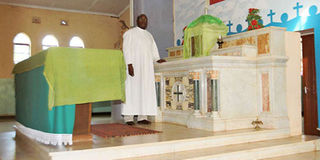Where old and new systems of worship meet

The two altars at Mulala Catholic Church in Makueni County. The old altar is a reminder of the past while the new one serves a modern purpose. PHOTO | PIUS MAUNDU | NATION MEDIA GROUP
What you need to know:
- The church is among a handful of churches in the world that chose to preserve the old altars.
- Mulala Catholic Parish has spawned the growth of dozens of other churches in the surrounding over the years.
Hundreds of worshippers fill Mulala Catholic Church every Sunday, yet many are unaware of the salient features that make the church unique.
The church in the sleepy Mbitini area, in the heart of Makueni County, resembles any other Catholic church, except that it has two altars.
The bigger altar is bedecked with marble while the other is a simple wooden structure. The first altar is no longer used. It’s obsolete.
The bigger altar faces the wall where the eyes of the worshippers are fixed. The other one is wooden.
“The wooden altar was installed after the Second Vatican Council in 1962, when the Catholic Church decided that a priest should conduct Mass facing the congregation instead of showing them his back.
The church also allowed priests to conduct Mass in different languages, in line with the resolutions at the meeting convened in Rome, Italy, by Pope John the 23rd.
LANGUAGE BARRIER
Until then, Mass in Catholic churches worldwide was conducted in Latin. But there was rising concern that the exclusive use of Latin hampered evangelism, since it limited understanding to those who were fluent in the language.
The news that congregations could now hear Mass in their languages was, therefore, received with jubilation by millions of Catholics across the world. The changes were meant to enhance the spread of Christianity across the world,” says Father Joseph Makite, the priest in charge of the Mulala Catholic Parish.
Many churches quickly demolished the old altars and replaced them with new ones facing the congregation.
But the Mulala church is among a handful of churches in the world that chose to preserve the old altars.
HISTORY
Some churches retained their altars, saying demolishing the structures could affect the stability of the entire building.
Yet other churches spared the altars because they were a heritage made of expensive materials such as marble.
“The first altar is fixed, so it was not easy to bring it down. Besides, it made no sense demolishing it since the sanctuary was large enough to accommodate a second one,” Father Makite explains.
The old altar is a reminder of the past while the new one serves a modern purpose.
Mulala Catholic Parish has spawned the growth of dozens of other churches in the surrounding over the years. The parish also boasts the prestigious Mulala Girls High School and a hospital.
The Mbitini community is so attached to the church that all the furniture was donated by Kibwezi West MP Patrick Musimba, while its power generator was donated by Machakos Governor Alfred Mutua. The two leaders trace their roots to the region.
CONVERTS
The church was the first modern one in the region to be built.
It was built by the Holy Ghost Fathers in the late 1940s to cater to the swelling numbers of faithful.
A fresh coat of peach orange paint on its exterior walls makes the church standout in the countryside.
A painting of a human heart by Father Makite sits conspicuously on its façade, symbolising the dedication of the missionaries to spread the gospel in a region whose inhabitants resisted Christianity.
“The Holy Ghost Fathers dedicated the mission to the sacred heart of Jesus so that his love could enable the locals to accept Christianity,” Father Makite says.
Is there a site you want us to feature? Write an e-mail to [email protected]





